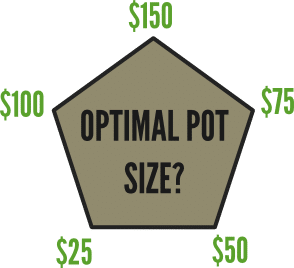In every single hand we play we want to have some sort of plan, even if that plan is simply “We are going to stack this off every time” or “We are not stacking off postflop without the nuts against this player.” However, planning is usually a pretty new topic to many players, so this article will offer a basic checklist to help with the planning process. Here are some things we always want to consider when planning a poker hand:
-
Who is our opponent?: We always need to know who our opponent is. We have vastly different plans versus a nit than a fish, and different plans versus a TAG than an unknown. We also need to think about how our opponent makes mistakes. If we have lots of information and history we can choose very specific and optimal lines. If we have very little information, we might rely more heavily on default lines/ideas versus that opponent type. “Who is my opponent and what kind of mistakes are they likely to make here?” should really be our first question whenever we are building a plan.
-
What is the board?: Assuming that we are postflop, we want to consider what the board is. What texture are we dealing with? Is it wet or dry? How would our opponent react on this texture? And not only do we need to think about the board texture now, but also the future texture when creating lines. Are there lots of clean future cards? Or are many future cards bad for either of our hands?

-
How does our opponent hit this board?: Thinking about the board texture, we want to consider how our opponent’s range hit this board. We can also think about how this opponent is likely to react on this board (e.g. is he more likely to bluff raise his air hands?). We can use a program like Flopzilla for this, but it does necessitate some range reading ability. If our opponent will likely continue if we bet, we might not bluff this hand. Conversely, if he is likely to continue liberally, our thinner value hands might shift closer to pure value.
-
What is our hand strength?: Depending on how our opponent hit and would continue on this board: what is our hand strength? Does our hand shift closer to value or showdown value (SDV) based upon his mistake-propensities? Does our SDV hand shift closer to a semi-bluff given the range he would call/raise our bet with? We should have some default lines created for each of our four hand strengths, which is why it is so important to classify our hand effectively and efficiently.
-
Is there any history here?: When applicable, we want to consider any history or reads we may have. Just remember that not all notes are relevant (just because a player bluff raised a river in a HU pot doesn’t mean he will raise liberally on a multi-way flop). Reads usually give us a better idea on our opponent’s mistake-propensities, and can help us select more precise and +EV lines.
-
What is our pot size goal?: Based upon all of the above, how big of a pot do we want to get involved in? Many players don’t consider this, and then find themselves in a massive pot with a weakish hand, and no idea how to make profit. We always want to have an idea on pot size goals, as they can help us decide whether we want to bet or check. There are times when a certain pot size would be -EV given our opponent and his logical range in that pot size, and thus we might take a different line. Think about how your own range changes as the pot gets bigger or smaller…

-
How can we create a +EV environment?: Keeping all of the above in mind, we want to consider how we can create the most +EV environment. If we bet, do we let our opponent play too close to perfect? Would another line create a more +EV situation for us? If we call this CR do we expect to be able to make money? If we 3bet this tough opponent, do we expect this to make us profit either now or later? As poker players we always need to be focused on creating and maintaining +EV situations, and we need to remember that when creating our plans.
While it may seem a bit clunky to ask ourselves this many questions at every point in a hand, it becomes automatic with time. Eventually, things like player type and mistake-propensities just become automatic (either from experience or understanding the truer meaning of HUD stats). Things like board texture and range contortion become easier with experience, stats, and player types as well. The main thesis here is to always be thinking a step ahead and considering past, current, and logical future actions.
